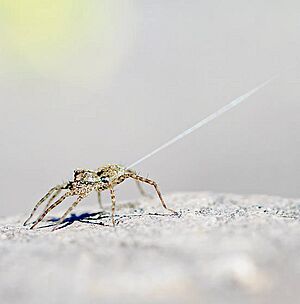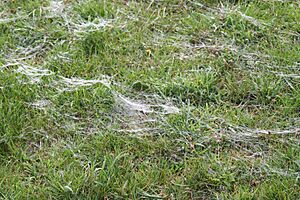Ballooning (spider) facts for kids

Ballooning, also called kiting, is a cool way some spiders and other tiny creatures travel through the air. They do this by letting out thin silk threads, like a tiny parachute, to catch the wind. This makes them float high up, carried by air currents and even electric fields. Scientists found in 2018 that electric fields can actually lift spiders and might even make them want to balloon!
Most of the time, young spiders (called spiderlings) use ballooning to spread out and find new homes. But sometimes, bigger spiders do it too. To start, a spider climbs to a high spot, points its bottom (abdomen) up, and lets out super fine silk threads from its spinneret. Soon, it lifts off!
Spiders can travel just a few meters or even hundreds of kilometers this way. Spiders have even been found on ships far out at sea and in air samples taken by balloons high up in the sky. But ballooning can be risky. Spiders might meet predators or land in a bad place.
Many kinds of spiders balloon, like Erigone atra. Some spider mites and even certain moths and butterfly species also use this trick. Scientists think ballooning might have started a very long time ago, during the time of dinosaurs! A study from the 1920s and 1930s found that about 1 in every 17 tiny creatures caught in the air was a spider.
How Spiders Balloon
Ballooning is how spiders and other small creatures travel through the air to new places. A spider, usually a small one or a young spiderling, will climb as high as it can. Then, it stands on its raised legs with its bottom pointing up, almost like it's tiptoeing. From its spinnerets, it releases several silk threads into the air.
These threads quickly form a triangle-shaped parachute. Even a tiny breeze can then carry the spider away. The Earth's natural static electric field can also help lift spiders, even when there's no wind. This electric field might even be what tells a spider it's a good time to balloon!
Many spiders use a special, very fine silk called gossamer to lift off. Spiders can also use this silk to anchor themselves down if they want to stop their journey. The word "gossamer" is often used to describe anything super thin and light.
Most spiders heavier than about 1 milligram (which is super tiny!) probably don't balloon. Since many spiders don't survive ballooning, adult spiders are less likely to do it than spiderlings. However, some larger female spiders, weighing over 100 milligrams, have been seen ballooning. They do this on hot, windless days by using rising warm air currents called thermals. These bigger spiders use many silk strands, which can form a silk sheet about 1 meter long and wide.
In Australia, people have reported seeing millions of spiders ballooning at once. Their silk covered the ground, making it look like snow! This happened in 2012 and again in May 2015.
How Far and High Can They Go?
Most ballooning trips only last a few meters. But if a spider is light enough and in the right position, it can get caught in a fast-moving jet stream high in the sky. How far they go also depends on air currents and how much the silk parachute drags in the wind.
Sailors have seen spiders caught in their ship's sails over 1,000 kilometers (about 620 miles) from land! Spiders have even been found in air samples collected by balloons nearly 5 kilometers (about 3 miles) above the sea. This shows that ballooning is the most common way spiders reach isolated islands and mountaintops. Young spiders can survive for 25 days or more without food while traveling in these high-altitude air currents.
Some mites and even some caterpillars also use silk to float through the air.
Scientists have also found that spiders that balloon are often good at surviving on water. Their water-repellent legs help them stay alive on both fresh and salt water, even in waves up to half a meter high. In windy conditions, many species raise their legs or abdomens like sails to move across the water's surface. Many spiders also drop silk to anchor themselves in place while floating. Spiders don't show these behaviors on land, which means they are special ways to adapt to water.
History of Studying Ballooning
People have known about spiders floating in the air since the time of Aristotle, a famous ancient Greek thinker. But the first detailed observations were written down by a spider expert named John Blackwall in 1827. Since then, many studies have helped us understand this behavior.
One of the biggest studies on ballooning was paid for by the United States Department of Agriculture. It happened between 1926 and 1931. The results were published in a long report in 1939 by P. A. Glick.
See also
- Charlotte's Web – A famous book featuring a spider.
- Aeroplankton – Tiny living things that float in the air.
- "A Noiseless Patient Spider" – A poem by Walt Whitman about spider ballooning.
- Organisms at high altitude – Other living things found high up.
- Spider silk – More about the amazing material spiders make.




